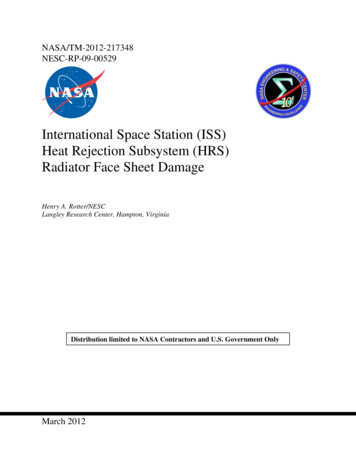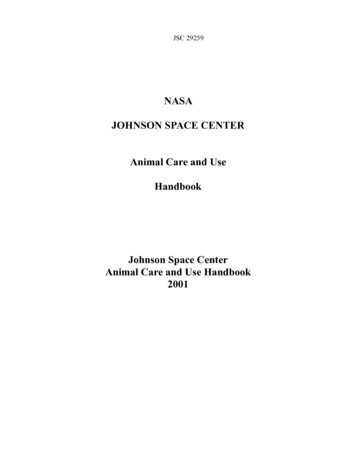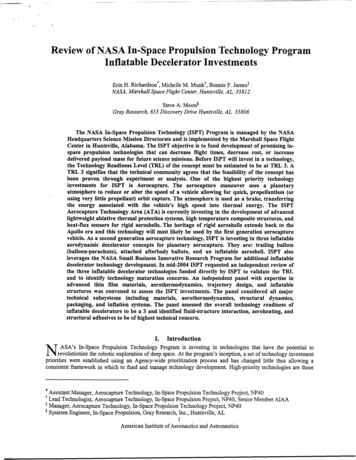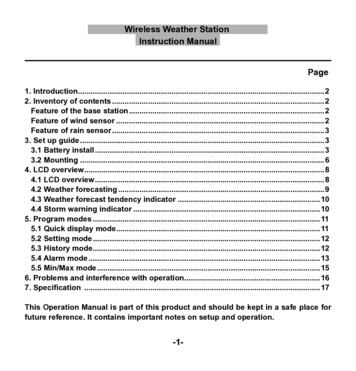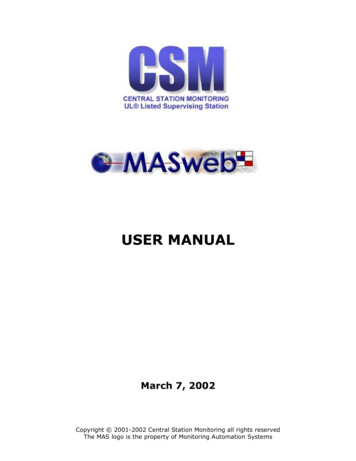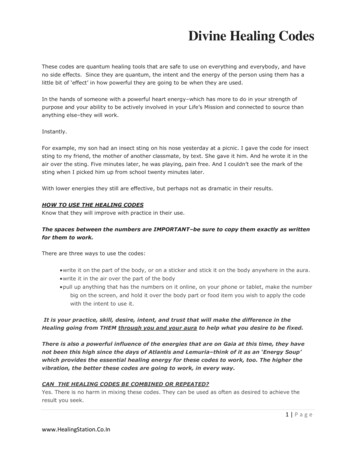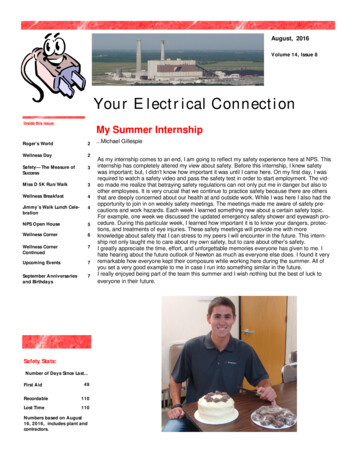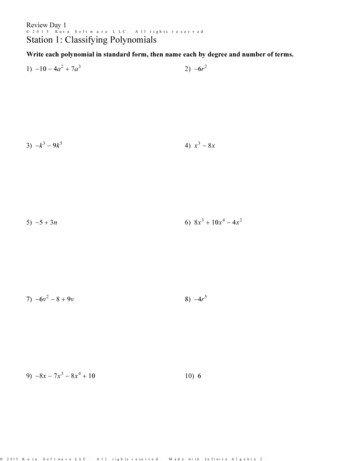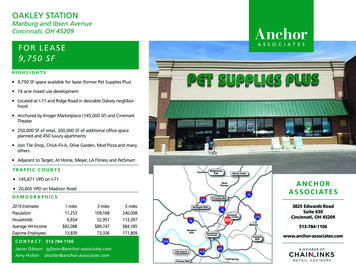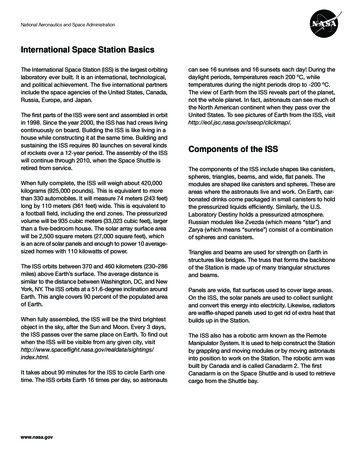
Transcription
National Aeronautics and Space AdministrationInternational Space Station BasicsThe International Space Station (ISS) is the largest orbitinglaboratory ever built. It is an international, technological,and political achievement. The five international partnersinclude the space agencies of the United States, Canada,Russia, Europe, and Japan.The first parts of the ISS were sent and assembled in orbitin 1998. Since the year 2000, the ISS has had crews livingcontinuously on board. Building the ISS is like living in ahouse while constructing it at the same time. Building andsustaining the ISS requires 80 launches on several kindsof rockets over a 12-year period. The assembly of the ISSwill continue through 2010, when the Space Shuttle isretired from service.When fully complete, the ISS will weigh about 420,000kilograms (925,000 pounds). This is equivalent to morethan 330 automobiles. It will measure 74 meters (243 feet)long by 110 meters (361 feet) wide. This is equivalent toa football field, including the end zones. The pressurizedvolume will be 935 cubic meters (33,023 cubic feet), largerthan a five-bedroom house. The solar array surface areawill be 2,500 square meters (27,000 square feet), whichis an acre of solar panels and enough to power 10 averagesized homes with 110 kilowatts of power.The ISS orbits between 370 and 460 kilometers (230–286miles) above Earth’s surface. The average distance issimilar to the distance between Washington, DC, and NewYork, NY. The ISS orbits at a 51.6-degree inclination aroundEarth. This angle covers 90 percent of the populated areaof Earth.When fully assembled, the ISS will be the third brightestobject in the sky, after the Sun and Moon. Every 3 days,the ISS passes over the same place on Earth. To find outwhen the ISS will be visible from any given city, tings/index.html.It takes about 90 minutes for the ISS to circle Earth onetime. The ISS orbits Earth 16 times per day, so astronautswww.nasa.govcan see 16 sunrises and 16 sunsets each day! During thedaylight periods, temperatures reach 200 ºC, whiletemperatures during the night periods drop to -200 ºC.The view of Earth from the ISS reveals part of the planet,not the whole planet. In fact, astronauts can see much ofthe North American continent when they pass over theUnited States. To see pictures of Earth from the ISS, nents of the ISSThe components of the ISS include shapes like canisters,spheres, triangles, beams, and wide, flat panels. Themodules are shaped like canisters and spheres. These areareas where the astronauts live and work. On Earth, carbonated drinks come packaged in small canisters to holdthe pressurized liquids efficiently. Similarly, the U.S.Laboratory Destiny holds a pressurized atmosphere.Russian modules like Zvezda (which means “star”) andZarya (which means “sunrise”) consist of a combinationof spheres and canisters.Triangles and beams are used for strength on Earth instructures like bridges. The truss that forms the backboneof the Station is made up of many triangular structuresand beams.Panels are wide, flat surfaces used to cover large areas.On the ISS, the solar panels are used to collect sunlightand convert this energy into electricity. Likewise, radiatorsare waffle-shaped panels used to get rid of extra heat thatbuilds up in the Station.The ISS also has a robotic arm known as the RemoteManipulator System. It is used to help construct the Stationby grappling and moving modules or by moving astronautsinto position to work on the Station. The robotic arm wasbuilt by Canada and is called Canadarm 2. The firstCanadarm is on the Space Shuttle and is used to retrievecargo from the Shuttle bay.
National Aeronautics and Space AdministrationComponents of the ISS (continued)ModuleZaryaUnityZvezdaZ1 TrussP6 TrussSolar ArrayDestinyCanadarm 2Quest AirlockPirs AirlockS0 Truss/MobileTransporterMobile BaseS1 TrussP1 TrussP3/P4 TrussP5 TrussS3/S4 TrussS5 Trusswww.nasa.govLength12.8 m (42 ft)5.5 m (18 ft)13.1 m (43 ft)4.6 m (15 ft)18.3 m (60 ft)73.2 m (240 ft)8.5 m (28 ft)16.9 m (56 ft)5.5 m (18 ft)4.9 m (16 113.4 m (44 ft)5.8 m (19 ft)13.7 m (45 ft)13.7 m (45 ft)13.7 m (45 ft)3.3 m (15 ft)13.7 m (45 ft)3.3 m (15 ft)200120022002200220062006To be launchedTo be launchedModuleNode 2ColumbusExperiment LogisticsModule (ELM)Pressurized Section (PS)DextreKiboS6 TrussELM Exposed SectionKibo Exposed FacilityRussian Multi-PurposeLaboratory ModuleNode 3CupolaRussian ResearchModuleSoyuzProgressLength6.1 m (21 ft)6.9 m (22.6 ft)LaunchedTo be launchedTo be launched3.9 m (12 ft)3.5 m (11.4 ft)11.2 m (36.7 ft)13.7 m (45 ft)4.9 m (16.1 ft)5.6 m (18.4 ft)To be launchedTo be launchedTo be launchedTo be launchedTo be launchedTo be launched12.8 m (42 ft)6.1 m (21 ft)3 m (9.8 ft)To be launchedTo be launchedTo be launched12.8 m (42 ft)7 m (22.9 ft)7.4 m (24 ft)To be launchedOngoingOngoing
National Aeronautics and Space AdministrationFour Easy Ways To Obtain NASA Educational MaterialsThe NASA Office of Education works collaboratively withNASA’s Mission Directorates to promote education as anintegral component of every major NASA research anddevelopment mission. These efforts result in innovativeand informative educational materials that engage studentinterest in science, technology, engineering, and mathematics. NASA makes these resources available in fourconvenient ways: Access educational resources online from NASA’sWeb site.http://www.nasa.gov/education/materials Visit a NASA Educator Resource Center (ERC).http://www.nasa.gov/education/ercn Order select materials through OfficeMax.http://www.nasa.gov/education/officemax Purchase materials from the Central Operation ofResources for Educators (CORE).http://www.nasa.gov/education/coreNASA’s ERC NetworkThe NASA ERCs are located throughout the United States,the U.S. Virgin Islands, and Puerto Rico. ERCs offerinformation about NASA and its educational resourcesand services. Personnel provide inservice and preservicetraining using NASA curriculum support materials. ERCteam members also collaborate with educational organizations to foster systemic initiatives at local, state, andregional NASA and OfficeMax have partnered to provide educatorswith a print-on-demand service to acquire NASA curriculumsupport materials. Using the Internet, educators can searchan online database of NASA materials, preview them,order online, and pick them up at the nearest OfficeMax—all for a nominal fee. If educators reside more than 50miles from an OfficeMax, the materials can be shipped tothem for an additional postage nasa.govThe NASA Web SiteThe NASA portal at http://www.nasa.gov serves as thegateway for information on missions, research, programs,and services offered by NASA. The educational sectionsprovide educators with access to curriculum supportmaterials and resources produced through collaborationswith NASA’s Mission Directorates. Materials may be downloaded and printed from the following locations:Educator Guides, Classroom Activities, Posters, Lithographs, Brochures, and emed Collections of Online /topnav/schedule/extrathemes/index.htmlClassroom Subject Matter pnav/subjects/about/index.htmlNASA Education Express Mailing ListSign up for announcements about NASA products sCORECORE serves as the worldwide distribution center forNASA-produced multimedia materials. For a minimalcharge, CORE will provide curriculum support materialsto educators who are not able to visit one of the NASAERCs or who are looking for large quantities of materials.Through CORE’s online catalog, educators can use themail-order service to purchase NASA education materials,such as classroom modules by subject area, DVDs, andCD-ROMs. Closed-captioned and audio-descriptive versions of many materials are available. More informationon CORE, including the online catalog, is available at thefollowing location: http://www.nasa.gov/education/core.
National Aeronautics and Space AdministrationIntegrated Truss BackgroundThe Integrated Truss Structure acts as a backbone for theInternational Space Station. A truss is a segment or partof the whole Integrated Truss Structure. The trusses areused to support the solar arrays and radiators. The solararrays provide energy for the Station, and the radiatorsget rid of extra heat that builds up in the Station. Whencomplete, the Integrated Truss Structure will contain 10segments and support 16 solar array panels. The totallength of the integrated structure will be equal to the lengthof a football field, including the end zones. Truss segmentsare labeled based on their location. P stands for “port,”which is a nautical term for “left.” S stands for “starboard,”which is a nautical term for “right.” Z stands for “zenith,”meaning “up” or “away from Earth.” External utilities likepower, data, and video are routed to the Station throughthe truss segment.The next truss segment to be installed was the P3/P4Truss, which supplied a second set of solar arrays andradiator panels. P5, which was the size of a sport utilityvehicle, was then attached to the end of P3/P4. As theremaining members of the truss are added, P6 will berelocated from its current location on Z1 and attached toP5 at the outer end of the Station’s port side.The truss structures are made of triangle shapes for strength.They are covered in panels to shield the utility cables fromimpacts with space debris, radiation from the Sun, and theharmful environment of space. In addition, the IntegratedTruss Structure has a rail cart that can move back and forthalong the trusses. Called the mobile transporter, the cartcan act as a base for moving the Station’s robotic arm whenassembling parts of the Station.The first truss segment to be added to the Station, calledZ1, was attached to the top of the Unity node module.Then truss segment P6 was mounted on top of Z1, andits solar arrays and radiator panels were deployed to support the early ISS. Subsequently, S0 was mounted on topof the Destiny laboratory, and the horizontal truss membersP1 and S1 were then attached to S0. P1 and S1 filled upthe entire Shuttle cargo bay. Each one is 13.7 meters (45feet) in length, which is the length of a school bus.This picture of the International Space Station shows the IntegratedTruss Structure.www.nasa.gov
National Aeronautics and Space AdministrationStraw Truss ActivityBackgroundOne of Educator Astronaut Barbara Morgan’s and TracyCaldwell’s jobs on STS-118 is to work together using therobotic arm to move the S5 Truss (which means the fifthstarboard truss segment) from the cargo bay of the SpaceShuttle to the International Space Station (ISS). Trusssegments are structures that make up the backbone ofthe ISS. They are made of triangle shapes for strength.The S5 Truss is the size of a sport utility vehicle. It will bethe connecting point for more solar arrays and radiators.External utilities like power, data, and video will be routedto the Station through the truss segment.Standard 9Students will develop an understanding of engineeringdesign and of the roles of troubleshooting, research anddevelopment, invention and innovation, and experimentation in problem solving.Procedures1. Show the picture of the ISS. Point out the truss. Explainthat it is the backbone of the ISS and is used to supportthe solar arrays, which power the Station.2. Divide students into teams of four. Give each team 50straws and 10 straight pins.3. Explain that students will work in teams to build modeltrusses out of straws.4. Challenge teams to build the longest and strongesttrusses possible between two chairs.5. Teams will test the strength of the trusses by weighingthem down with chalkboard erasers or textbooks.6. Discuss what types of structures were the strongest.Students should figure out that triangles are thestrongest. Have them examine the poster of the ISStruss. Are there triangles in the truss?AssessmentTeams will build models of truss structures for a spacestation using straws. They will test the structures forstrength by weighing them down with chalkboard erasersor books.Materials Box of drinking straws Straight pins Chairs Chalkboard erasers or textbooks Meter stickwww.nasa.govAstronauts work on part of the truss of the International Space Stationduring STS-115. Notice the triangle-shaped structure inside the truss.
National Aeronautics and Space AdministrationRemote Manipulator (Robotic) Arm BackgroundThe robotic arm of the ISS has a long name: Space StationRemote Manipulator System (SSRMS). Developed byCanada, the SSRMS is a bigger, better, smarter versionof the Space Shuttle’s robotic arm. It is 17 meters longwhen fully extended and has seven motorized joints. Thesejoints act like a shoulder, elbow, wrist, and fingers.This arm is capable of handling large cargos to constructthe ISS. The SSRMS can act like an inchworm; it canattach to one anchor pin at one end and flip the other endover to attach at another anchor pin.End EffectorThe part of the robotic arm that grabs objects is called an“End Effector.” This wire-snare device is designed to fitover special grapple fixtures (knobbed pins) on the Shuttle,ISS, and ISS modules.The End Effector is like a mechanical hand with a cylinder33.2 centimeters in diameter by 25.8 centimeters deep.It contains three cables (like a snare) that close around agrapple pin onto the module. Then the cables becomerigid with enough force to prevent the captured objectfrom slipping loose.Using the Robotic ArmThe movement of the robotic arm is controlled by the ISS’sarm control unit. The hand controllers used by the astronauts
the entire Shuttle cargo bay. Each one is 13.7 meters (45 feet) in length, which is the length of a school bus. The next truss segment to be installed was the P3/P4 Truss, which supplied a second set of solar arrays and radiator panels. P5, which was the size of a sport utility vehicle, was then attached to the end of P3/P4. As the remaining members of the truss are added, P6 will be relocated .
